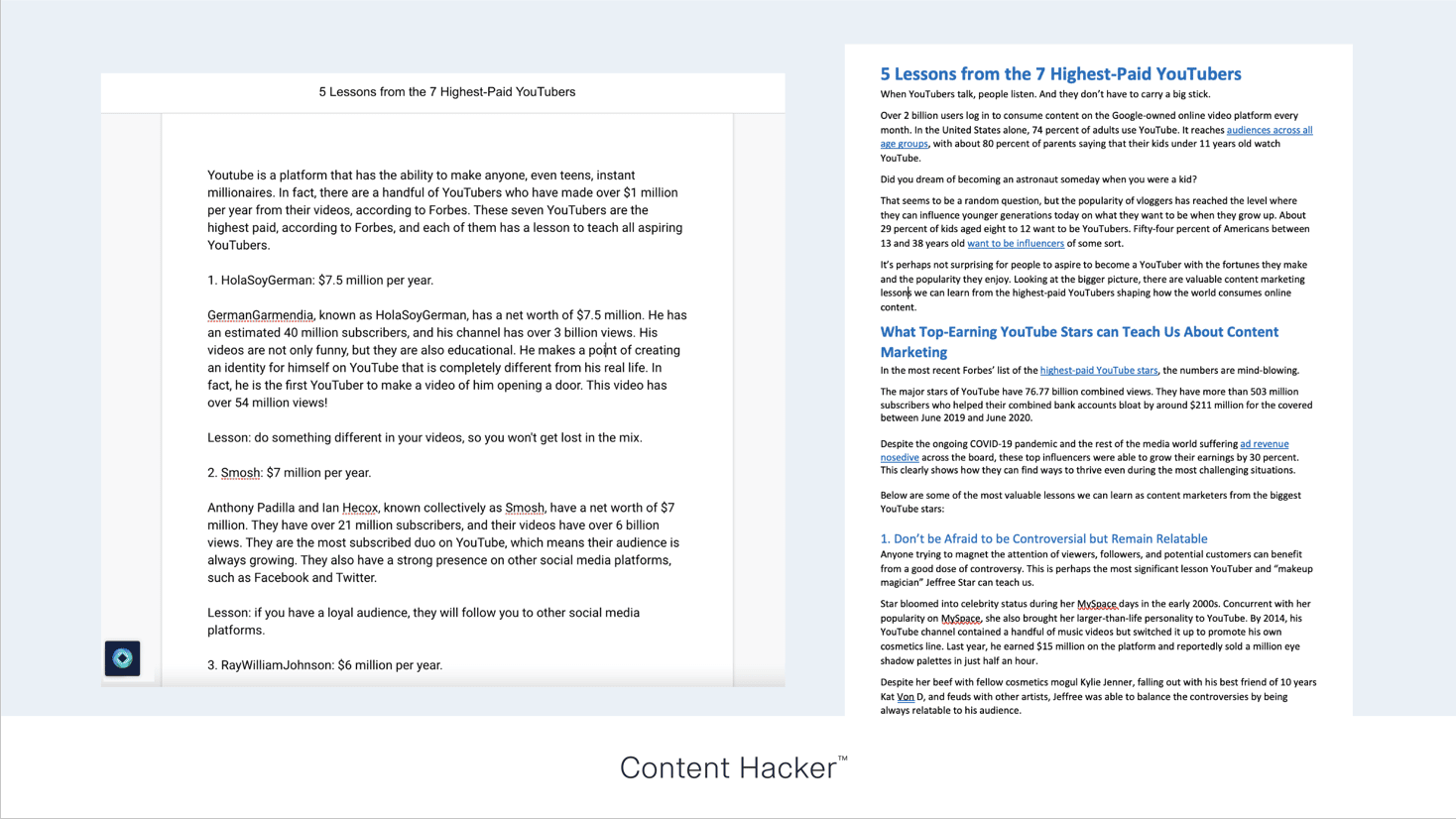With just a little prompting from humans, AI writing has the power to churn out mountains of content very quickly.
I’m talking 800-words-in-eight-minutes quickly.
If the average content writer needs 60 minutes to write 500 words…
That means AI writing can produce content at a rate roughly 12 times faster.
For a bit more scope, that means a human writing at a steady, 500-words-per-hour pace could produce a 100,000-word book in 13,833 hours (1.6 years).
A human-led bot could do it in 1,000 hours (roughly 41 days).
That’s a lot of power. Especially at a time when content marketing is the only marketing left.
Content isn’t just king these days – it’s the entire castle. 🏰
(The content marketing industry itself will be worth a staggering $600 billion by 2024.)
But relying on AI writing to produce all of your content is like handing the keys to an invading army.
Yep, it’s downright dangerous.
Why? Let’s discuss – I have a bone to pick with AI writing. 🦴
Why AI Writing Is Dangerous
I once considered AI writing in a cautious-yet-optimistic light.
Now?
Nope. I’ve changed my tune. 🙅♀️
There are just too many factors weighing against AI writing at this moment. Here are my main concerns:
1. Google Says It’s Spam
Lest we forget, remember Google recently said AI writing is spam. (I discuss the context of that statement in this post: Should You Play with Blog Writing AI?)
Specifically, Google is referring to unedited AI content, published with little-to-no human revision.
Sure, you can use AI writing tools with a heavy editing touch to avoid getting flagged, but are most people doing that?
I’d argue no.
AI writing tools are tempting precisely because of how much time they save. People aren’t using these tools as helpers; they’re using them to churn out content quickly and efficiently with little to no editing.
Ironically, the only way AI content isn’t spam is if it’s heavily revised, fact-checked, and edited. BUT – if you take the time to revise AI-written content so it’s unique and original, you’ll spend nearly as much time on it as you would writing it from scratch.
For many content creators and business owners, that defeats the point. Time is money. 💸 So they use AI indiscriminately, churn out mountains of mediocre-to-downright-crappy content, and expect it all to be okay.
But they’re playing with fire. 🔥
2. AI Writing Learns from What’s on the Web…
…And the web is a vast, scary place populated with human error: misinformation, bias, nonsense, bad grammar, and worse.
And, unfortunately, AI writing tools learn from sources like these right alongside reputable ones.
How? GPT-3, the language AI developed by the research laboratory Open AI, is an autoregressive language model. This means, simply, that it bases its predictions (e.g., what to write next after it’s given a prompt) on past information. This includes deep learning acquired from the web as well as how you interact with it and guide its output (via a tool like Jasper or Copy.ai).
Basically, if you supply it with biased data/opinions or inaccurate information, it will write in the same vein, drawing from what it learned already across the web from similarly biased or inaccurate sources. (This is just one part of the overarching issue of AI bias.)
GPT-3 often performs like a clever student who hasn’t done their reading trying to bullshit their way through an exam. Some well-known facts, some half-truths, and some straight lies, strung together in what first looks like a smooth narrative.
— Julian Togelius (@togelius) July 17, 2020
That leads us to the next problem.
3. AI Writing Is Often Rampantly Error-Ridden
I’ve taken some of the most popular AI writing tools for a spin: Jasper, Hyperwrite, and Copy.ai.
Not only that, but I test-drove a particular tool’s capabilities (HyperWrite) in direct comparison to one of my human writers.
HyperWrite is relatively low-cost. To use it, all you have to do is fill out a few prompts, tell it the type of content you want to write, and then let it go.
I will admit, it’s mind-bending to watch an AI writing tool form coherent paragraphs out of thin air in seconds. BUT…
Not everything is as it seems.
I gave one of my writers AND the AI the same prompt: to write about “5 Lessons from the 7 Highest-Paid YouTubers.” For the AI, it took mere minutes to spit out 800 words of content.
It wasn’t too bad at first glance. Nothing outstanding, but it wasn’t utter gibberish, either.
I checked the output on Copyscape, an online plagiarism checker and duplicate content tool, and found it was 100% original.
Meanwhile, my writer produced a 1,400-word blog post.
Here you can see them side by side:

Left: AI-generated content. Right: humanly-written content.
Looking beyond the glaring differences in the quality and style of the writing, right off the starting block, the AI made a giant error: It did not find the correct highest-earners on YouTube.
The AI picked a YouTuber earning $7.5 million/year and missed including Blippi, a super-popular U.S. YouTuber earning $17.5 million.
There’s a $10M difference between these two. That’s HUGE.
If I publish the error-ridden AI-written blog indiscriminately, that’s not on the AI. That’s on ME, the content creator. That’s MY authority that gets downgraded when my audience calls me out on those mistakes. (Because people are smart, they’re paying attention… and they’re often ruthless about errors. In one consumer survey, 55% said they give brands one chance for a mistake before moving on.)
And right now, even one hit to your brand trust can be too much.
4. Trust Matters Too Much to Rely on AI Writing
We’re living in what I like to call “the call-out age.”
If a brand makes a wrong move, its audience will call it out. They expect mega-responsibility from the brands they trust.
To put that in perspective, business is the only institution people view as both competent and ethical, according to the 2021 Edelman Trust Barometer. People trust businesses more than their governments, more than media outlets, and more than nonprofits (NGOs).

Trust is HUGE – it’s why we create content and nurture our audiences. Because trust translates to loyalty and sales.
For most consumers, it matters even more than price, availability, or product quality!

Source: Blis
SO.
Imagine if the blog topic above (“5 lessons from the highest-paid YouTubers”) had even higher stakes. What if it wasn’t just a matter of sharing relatively benign, incorrect facts?
Imagine if I was publishing content with AI-generated misinformation that could affect someone’s health, livelihood, or well-being.
That’s a giant problem, and Google agrees.
Listen to my podcast episode where I talk about why trust matters so much today:
Find all podcast episodes here.
5. Google’s E-A-T and YMYL Guidelines Are Stricter Than Ever
The search engine recently updated its E-A-T and YMYL guidelines this summer. Now, Google is more restrictive than ever about content published in high-level industries, requiring a greater level of expertise and finesse in the writing…
…that only a human can deliver. 👫
Remember:
- YMYL = Your Money or Your Life. Google now defines YMYL content by its potential to cause the reader harm. For example, a blog with bad information about when to go to the emergency room could cause harm to someone following that information.
- E-A-T = Expertise, Authoritativeness, Trust. These three factors help Google determine the quality of a piece of content. Google has now clarified that, even if a website has high E-A-T overall, if it shares content that’s deceptive, spammy, harmful, etc., that page will be deranked.
AI’s inaccuracies, even for relatively low-risk topics, are therefore something we can’t ignore. Even one could spell death for your brand’s reputation.
6. AI Writing Is Missing Creativity and Empathy
Let’s circle back to that experiment I performed, pitting the AI writing tool against the human writer.
🤖💥👩💻
When it comes to style, flair, empathy, emotion, color, and life…
Is it any surprise that the human writer wins by a landslide?
Let’s zoom in on the introductions of the competing pieces to show you what I mean.
AI writer:

Human writer:

Compared to the human writer, the AI seems repetitive, stale, and, well… robotic. This bot is fooling no one.
The human writer’s intro, meanwhile, has a nice flow + sentence variety, and more descriptive, engaging language.
Ultimately, it has 100% more empathy – the writer invites us to imagine other perspectives, for instance – and that makes a world of difference.
Bottom line, consumers aren’t easily fooled. Chances are, they’re going to recognize bot-written content that’s missing a human touch, and that may result in people losing trust.
Will AI Writing Ever Replace Human Content Creators?
My prediction: It’s unlikely AI writing will fully replace human writers, no matter how futuristic GPT-3, 4, and its successors become.
I’ve been in the content marketing business for over a decade, and I make a point to study AI advancements in my industry at least once a year.
Back in 2017, my industry hero, Joe Pulizzi, shook me when he left a comment on my CMI article predicting that most content would be software-generated by the year 2027. That’s when I took it upon myself to stay up-to-date on AI.

Now, here we are in 2022. And despite the remarkable growth and development in AI over the last few years, I still stand by my belief that AI writing will never replace human writers and write 100% of the content in the future.
To write content that appeals to humans, you need human experiences. You need to be able to tell stories.
AI-written content completely lacks this storytelling flair. It’s missing the human heart and creativity that spark joy and wonder and fear and love and every other emotion under the sun.
Without all of that, AI will never replace human writers.
Your Content Is Too Important to Trust to AI Writing Bots
Content marketing is one of the best and most important ways to connect with your audience.
It’s how you build trust in a reshaped world where trust between consumers and businesses is #1.
But if you leave your content to bots…
You’re walking a very fine line between building trust and courting disaster.
It’s just not worth it.
Instead, you should focus on building your business in such a way that your content runs like clockwork in a seamless system. With this in place, you’ll never need bots. ❌🤖
And to make THAT happen, you need a strong content marketing and business strategy in place first.
Before you can take advantage of content for growing your authority and audience, you need those foundations set.
And if you don’t have those foundations, you need to learn how to build them.
That’s exactly what my coaching/mentorship program, The Content Transformation System, is all about.
I built a 7-figure business out of content marketing, and this program teaches you the exact pathway I took to get there, including the systems, strategies, and skills you need to make it happen.
If you’re struggling to start, grow, or scale your business, this is your solution. Watch my free class today to see if you’re a good fit. Hope to see you inside!










